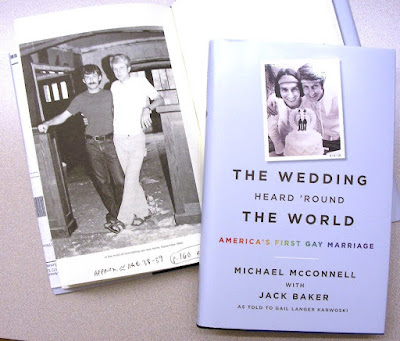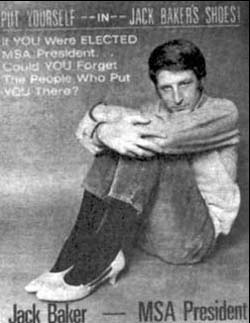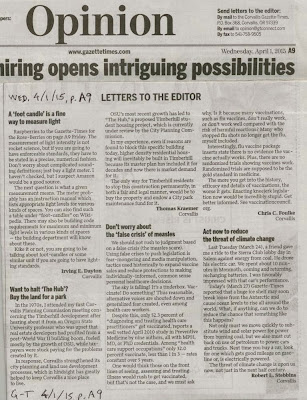
PHOTO: A major business magazine recently featured a two-page fashion spread on men's sandals for the summer: "Stand by your Mandal, Fashion: The much derided 'mandal' is actually the perfect summer sneaker alternative," Businessweek, May 23-20, 2016, p. 68-69. This is remarkable because only a few decades ago, the standard "dress for success" advice given to businessmen was never be seen wearing sandals, except on the beach, in order to avoid being stigmatized as being 'too gay.'
Despite the decades-old "dress for success" advice for businessmen not to wear sandals, except on the beach, in order to avoid looking "too gay," I can clearly recall in the 1950's how common it was to see men, of all economic classes and races, wearing sandals in the Deep South of America because few buildings were air conditioned back then and the hot, high humidity climate made it a practical thing to do. Of course, upper class businessmen would wear dressier leather sandals with black socks, instead of wearing the standard rubber flip-flop sandals worn by the commoners. In addition to the lack of air conditioning, many men in the Deep South justified wearing sandals for the medical reason of avoiding aggravating their foot fungus problem they acquired serving as military infantry men in World II or Korea.

PHOTO: A Sept. 1980 photo of gay marriage pioneers, Mike and Jack, wearing sandals, while remodeling their home in Minneapolis, Minnesota, is shown on p. 152 of the book by Michael McConnell, with Jack Baker, as Told to Gail Langer Karwoski, "The Wedding Heard 'Round the World - America's First Gay Marriage," University of Minnesota Press, 2016. (See previous posts Book by Michael McConnell on his marriage to Jack Baker that led to the first Supreme Court case on gay marriage (12/29/15) and My notes on autobiography by Michael McConnell with Jack Baker gay marriage activism (2/14/16))
When my family moved to Minnesota in 1960, which has a milder climate than Louisiana where I grew up, the only sandals I saw Minnesota men wearing were typically the rubber flip-flops on the beaches of Minnesota's 10,000 lakes. By the 1960's sandals had become negatively associated by the public with the beatnik generation and then with the 1960's peace movement and free-spirited "hippies." As a result, sandals on men went out of fashion.
Likewise, I can clearly recall my father warning me that only gay queer guys wore sandals, by telling me how everyone would beat up any guy wearing sandals when he was a boy in the 1930's.
In fact, during the 1970's in Minneapolis, most of the men I saw wearing sandals was either in a gay bar or clueless about the stigma surrounding sandals making a man look effeminate and gay. Indeed, women's fashion has always included sandals, although men also wore sandals in Greek and Roman times, perhaps partly because they were easier to make than a shoe or boot.
During the 1980's in the mild rainy weather of Oregon, I quit wearing any type of sandals and started wearing mostly the new Nike running shoes that were first designed by Nike's founder and the former University of Oregon track coach Phil Knight, forty miles south of OSU.
One thing I first noticed, after moving to the West Coast in the 1970's, is the fact that on the East Coast, everyone called the Nike style of shoe a "sneaker," ala the old rubber sole Ked shoes that were popular back then. However, people on the West Coast of the U.S. called this type shoe something else, such as athletic shoes, "tenny runners (short for tennis shoe)," or running shoes, etc. I still hear people on TV today using the word "sneakers" Back Rast, but some other word if they are from the West Coast.
In the 1990's the Teva sandal (the Hebrew word for "nature" pronounced with a short "e") quickly became popular out west in Colorado, where I was living at the time, because not only could they be worn for river rafting in the mountains, but they could be worn without or without socks as a fashion statement. Of course, at the time, many people considered it to be a fashion no-no to wear socks with sandals. The Teva is one of the sandals featured in the Businessweek fashion spread shown in the photo above.
In the 1980's, I was living in California when I first saw high-quality leather flip-slops instead of the usual cheap rubber ones. These made sense for the mild California climate and could be worn during most of the year. These expensive leather sandals were popular with California men and I was not surprised to find out that most of them were being made in Hawaii, where the weather is also perfect for wearing sandals all year long.
Recently, while looking for a replacement for my Nike and Scotts Hawaii leather sandals, which I bought in California over 20 years ago, I discovered another Hawaiian leather sandal maker, OluKai Sandals. (See OluKai FAQ page that says, "The Polynesian culture is an oral history, passed along through storytelling. Naming our products with Hawaiian words is our small way of spreading and preserving the culture for future generations.")
I ended up looking at OluKai Men's sandals, and all OluKai Men's sandals Size 10), before buying two of their model Olukai Nui (noo-ee) Translation: Greatest in color tan/tan for $85 each. (NOTE: Please NOTE that this blog is NOT a paid advertisement -- I am just a happy customer!) The description says, "Decorative stitching on foot bed, hand-sewn whip stitching, soft nylon toe post, embroidered logo. Non-marking rubber and gum rubber outsole with island inspired pod design. Compression-molded EVA footbed topped with premium full-grain leather. Anatomically correct contour for a personalized fit and sustained comfort over time. Our thermoset rubber is a compound of natural and synthetic rubber that will not leave marks or 'scuffs' on surfaces of any type. Our gum rubber outsoles, as a natural material, will always naturally be non-marking."
I also looked at Men's Sandals llbean.com, Men's Sandals Flip Flops llbean.com that has Men's Teva Lux Terra-Float Flip-Flop.
Of course, I also had to check out the very gay Abercrombie & Fitch men's leather flip-flops at "Mens Flip Flops" abercrombie.com accessed Mar. 9, 2016. These were very popular with college fraternity boys a few years ago. (See previous post Gay CEO of Abercrombie goes out of fashion but I still love his leather flip-flops (1/25/15).)
Specifically, I looked at the Leather Flip Flops $48 Shown In dark brown that is described as: "Soft and comfortable, Footbed and upper are genuine nubuck leather. Slimmer foot bed silhouette with new composite for overall comfort. Super soft micro-fiber elastic on back of upper." I noticed that this isn't real leather like previous pair that I owned, would be OK for wet rainy Oregon, but would ot as comfortable as wering leather soles.
Bruce Weber is the fashion photographer behind the very successful look and feel of the Abercrombie and Fitch mail order catalog and store display photographs. Young gay boys were the first to latch onto the A&F fashion before it became so mainstream in every mall in America that it lost its fashion appeal. Despite A&F being going out of fashion, there are still gay men today who subscribe to the A&F catalog just to get the erotic pictures of hunky guys.
For years, the CEO of Abercrombie personally famously wore the leather sandals he sold, even to company boardroom and business meetings. (See article by Benoit Denizet-Lewis, "The man behind Abercrombie & Fitch, Mike Jeffries turned a moribund company into a multibillion-dollar brand by selling youth, sex and casual superiority. Not bad for a 61-year-old in flip-flops," Salon.com posted Jan. 24, 2006 and previous posts Bruce Weber Chop Suey movie and book (8/24/09) and Gay CEO of Abercrombie goes out of fashion but I still love his leather flip-flops (1/25/15).)
I didn't spend any time looking at Birkenstocks, which are a lesbian staple in the college town where I now live. Businessweek says, "Birkenstocks have been sold in the U.S. since 1966, when a woman named Margot Fraser started importing them after discovering the shoes on a German vacation. The business has had few ups and downs, with the exception of a faddish bump in the 1990s. Since then sales have been stable, buoyed by hippies, preppies, and Vermonters who stuck with Howard Dean after the scream. But in the past two years, something strange has been happening to Birkenstocks: They've gotten kind of cool." (See story by Kurt Soller, "Birkenstocks, the preferred sandals of hippies, have risen again. This time, the company has a plan to keep them on top," bloomberg.com posted June 26, 2014)
Men wearing sandals may have been considered gender-bending at one-time in certain parts of the U.S., but men wearing high-heels has always been considered to be queer, which is why the campaign poster of Jack Baker wearing high-heels caught the eye of many University of Minnesota students circa 1971:
 PHOTO: Jack Baker used this poster, circa 1971 that made fun of the stereotype that all gays are drag queens, during his successful run for student body President, using the campaign slogan, "Put yourself in Jack Baker's shoes," to become the first openly gay person elected to be the University of Minnesota student body president. See my previous posts Gay U of M student body presidents Chris Armstrong and Jack Baker (10/3/10), Life Magazine 1971 gay liberation story (7/20/08), Life Magazine gay marriage 1971 (11/20/08), and Jack Nichols, Gay Pioneer" biography (3/19/08)
PHOTO: Jack Baker used this poster, circa 1971 that made fun of the stereotype that all gays are drag queens, during his successful run for student body President, using the campaign slogan, "Put yourself in Jack Baker's shoes," to become the first openly gay person elected to be the University of Minnesota student body president. See my previous posts Gay U of M student body presidents Chris Armstrong and Jack Baker (10/3/10), Life Magazine 1971 gay liberation story (7/20/08), Life Magazine gay marriage 1971 (11/20/08), and Jack Nichols, Gay Pioneer" biography (3/19/08)

PHOTO: The May 17, 2015 Sunday New York Times newspaper featured the 1971 marriage of Jack Baker and Michael McConnell on the front page in a news article by Erik Eckholm, "Same-sex marriage? Done That, Back in 1971," New York Times, Sunday edition (as printed in Seattle) May 17, 2015, p. 1, 15 also published online as "The Same-Sex Couple Who Got a Marriage License in 1971" nytimes.com posted May 16, 2015. (See previous post Baker marriage hits N.Y. Times front page only 4 decades late (5/17/15)) NOTE: The above is an original photograph taken by Thomas Kraemer (c) 2015 who grants limited copyright permission for it to be reposted by others provided a link and text citation is provided to this blog post.






